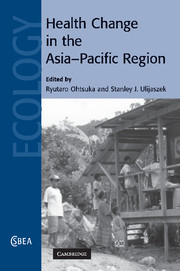Book contents
- Frontmatter
- Contents
- List of contributors
- Acknowledgements
- 1 Health change in the Asia-Pacific region: disparate end-points?
- 2 Interactions of nutrition, genetics and infectious disease in the Pacific: implications for prehistoric migrations
- 3 Biocultural adaptation and population connectedness in the Asia-Pacific region
- 4 Changing nutritional health in South East Asia
- 5 Obesity and nutritional health in Hong Kong Chinese people
- 6 Modernization, nutritional adaptability and health in Papua New Guinea Highlanders and Solomon Islanders
- 7 Tongan obesity: causes and consequences
- 8 Nutrition and health in modernizing Samoans: temporal trends and adaptive perspectives
- 9 Health patterns of Pacific Islanders and Asians in the United States
- 10 Impacts of modernization and transnationalism on nutritional health of Cook Islanders
- 11 Mortality decline in the Pacific: economic development and other explanations
- 12 Health changes in Papua New Guinea: from adaptation to double jeopardy?
- Index
- References
12 - Health changes in Papua New Guinea: from adaptation to double jeopardy?
Published online by Cambridge University Press: 15 September 2009
- Frontmatter
- Contents
- List of contributors
- Acknowledgements
- 1 Health change in the Asia-Pacific region: disparate end-points?
- 2 Interactions of nutrition, genetics and infectious disease in the Pacific: implications for prehistoric migrations
- 3 Biocultural adaptation and population connectedness in the Asia-Pacific region
- 4 Changing nutritional health in South East Asia
- 5 Obesity and nutritional health in Hong Kong Chinese people
- 6 Modernization, nutritional adaptability and health in Papua New Guinea Highlanders and Solomon Islanders
- 7 Tongan obesity: causes and consequences
- 8 Nutrition and health in modernizing Samoans: temporal trends and adaptive perspectives
- 9 Health patterns of Pacific Islanders and Asians in the United States
- 10 Impacts of modernization and transnationalism on nutritional health of Cook Islanders
- 11 Mortality decline in the Pacific: economic development and other explanations
- 12 Health changes in Papua New Guinea: from adaptation to double jeopardy?
- Index
- References
Summary
Introduction
Are the health patterns of Papua New Guinea (PNG) changing? If so, in what ways are they doing so? Specifically, are they changing in line with theoretical models which invoke modernization, development and globalization to account for the decline of infections and the rise of lifestyle- and ageing-related health problems? Or does communicable disease – persistent, recrudescent or emergent – still predominate? In this review, I aim to discuss selected evidence on the health of Papua New Guineans, with a particular focus on examining past trends and on considering, so far as possible, future prospects – whether by projection from the past or on some other rationale. In the process, I shall consider the adequacy of conventional health modernization models to describe PNG's present situation.
To be modern is to have characteristics typical of recent times and the present day, by contrast with the more distant past. This sounds open-ended; but, in the health sciences as in the arts and social sciences, modernity is (explicitly or implicitly) expected to bring changes of a specific character. This follows usually from the concept that socioeconomic modernization, discussed by Ulijaszek (1995), is accompanied, anywhere in the world and whenever it may take place, by a demographic, health or epidemiological transition (Caldwell et al. 1990; Riley 2001). In such transitions, not only are death rates alleviated and life expectancies increased, but also one set of causes of ill-health (life-threatening and otherwise) declines in importance, to be replaced by a different set.
- Type
- Chapter
- Information
- Health Change in the Asia-Pacific Region , pp. 254 - 302Publisher: Cambridge University PressPrint publication year: 2007
References
- 1
- Cited by

